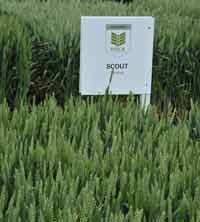Group 3 wheat Scout set to make a mark

Newly approved biscuit wheat Scout, the only Group 3 wheat to make it on to the Recommended List for 2009, should take 3.5% of the winter wheat market this autumn, predicts its breeder Senova.
Further ahead, demand for soft milling and export varieties is expected to help the Group 3 market double in size from its current low of 10% to about 20% by 2010, Jeremy Taylor, the company’s commercial director, says.
“The Group 3 sector has suffered since 2005, due to the twin effects of better grain prices and the introduction of some very high yielding Group 4 varieties,” he says.
“The only new Group 3 wheat to come along in that time was Zebedee, which failed to make much impact.”
That situation is now changing, he says. Demand from end users means there is scope for new varieties and an increased market share for Group 3s, which was why many were disappointed when KWS’s Viscount and Nickerson’s Cassius failed to be awarded Group 3 status in the 2009 HGCA Recommended List.
That left the way clear for Senova’s Scout, which was the only new Group 3 to join the RL. “It comes at a time when the areas of others, such as Robigus, Claire and Consort are in decline,“ Mr Taylor says.
With the grain quality and processing characteristics needed by the biscuit and export markets, Scout also has the agronomic characteristics sought by growers, he says.

Visitors to Cereals 2008 came to see three new Group 3 varieties, but only one, Scout, made the RL list
“It has the highest specific weight of any of the soft wheats at 77.7kg/hl, a Hagberg of 218 and grain protein of 12%. In addition it has very stiff straw, good disease resistance and consistent performance across all soil types and rotational positions.”
Included in its disease resistance ratings is a 9 for eyespot, making it the only variety on the Recommended List with such a score, he reports.
“This gives it an advantage in the second wheat slot and should give growers more leeway with fungicide programmes.”
Scout also has a score of 9 for both yellow and brown rust, as well as resistance to orange wheat blossom midge, he adds. “It has good scores for septoria, mildew and fusarium too. Unlike the current Group 3 choices, there are no disease weaknesses.”
Its potential for early sowing is being investigated, says Mr Taylor. “There’s been some work done which suggests it has slow primordial development, so it could fill the void left by Claire.”
Emma Finn of British Cereal Exports confirms that Scout meets the requirements of the export market.
“Scout has provisional approval for the uks brand, which is always the case for the first two years of a variety’s life, and we’ve had very good feedback from end users about it.”
There are 12 varieties on the Recommended List which meet the uks specification, she adds.
“It tends to be the Group 3s which have the desired quality. Interestingly, uks is in high demand and it’s very difficult for our customers to find an alternative to it. It’s a good market for UK growers, which must be maintained.”
This means growers with access to ports should consider quality wheat, she stresses. “The export market is open to them. And now in Scout we have a new variety that fits the bill.”

